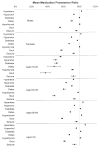Comparison of drug adherence rates among patients with seven different medical conditions
- PMID: 18363527
- PMCID: PMC2737273
- DOI: 10.1592/phco.28.4.437
Comparison of drug adherence rates among patients with seven different medical conditions
Abstract
Study objective: To compare drug adherence rates among patients with gout, hypercholesterolemia, hypertension, hypothyroidism, osteoporosis, seizure disorders, and type 2 diabetes mellitus by using a standardized approach.
Design: Longitudinal study.
Data source: Health care claims data from 2001-2004.
Patients: A total of 706,032 adults aged 18 years or older with at least one of the seven medical conditions and with incident use of drug therapy for that condition.
Measurements and main results: Drug adherence was measured as the sum of the days' supply of drug therapy over the first year observed. Covariates were age, sex, geographic residence, type of health plan, and a comorbidity score calculated by using the Hierarchical Condition Categories risk adjuster. Bivariate statistics and stratification analyses were used to assess unadjusted means and frequency distributions. Sample sizes ranged from 4984 subjects for seizure disorders to 457,395 for hypertension. During the first year of drug therapy, 72.3% of individuals with hypertension achieved adherence rates of 80% or better compared with 68.4%, 65.4%, 60.8%, 54.6%, 51.2%, or 36.8% for those with hypothyroidism, type 2 diabetes, seizure disorders, hypercholesterolemia, osteoporosis, or gout, respectively. Age younger than 60 years was associated with lower adherence across all diseases except seizure disorders. Comorbidity burden and adherence varied by disease. As comorbidity increased, adherence among subjects with osteoporosis decreased, whereas adherence among those with hypertension, hypercholesterolemia, or gout increased. Add-on drug therapies and previous experience with taking drugs for the condition increased adherence among subjects with hypertension, type 2 diabetes, hypothyroidism, or seizure disorders but not the other conditions.
Conclusion: This uniform comparison of drug adherence revealed modest variation across six of seven diseases, with the outlier condition being gout.
Figures



References
-
- Solomon DH, Avorn J, Katz JN, et al. Compliance with osteoporosis medications. Arch Intern Med. 2005;165:2414–19. - PubMed
-
- Brookhart MA, Patrick AR, Dormuth C, et al. Adherence to lipid-lowering therapy and the use of preventive health services: an investigation of the healthy user effect. Am J Epidemiol. 2007;166:348–54. - PubMed
-
- Ho PM, Rumsfeld JS, Masoudi FA, et al. Effect of medication nonadherence on hospitalization and mortality among patients with diabetes mellitus. Arch Intern Med. 2006;166:1836–41. - PubMed
-
- Hess LM, Raebel MA, Conner DA, Malone DC. Measurement of adherence in pharmacy administrative databases: a proposal for standard definitions and preferred measures. Ann Pharmacother. 2006;40:1280–8. - PubMed
-
- Briesacher B, Kamal-Bahl S, Hochberg M, Orwig D, Kahler KH. Three-tiered-copayment drug coverage and use of nonsteroidal anti-inflammatory drugs. Arch Intern Med. 2004;164:1679–84. - PubMed
Publication types
MeSH terms
Substances
Grants and funding
LinkOut - more resources
Full Text Sources
Medical
Research Materials
